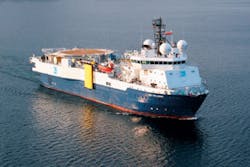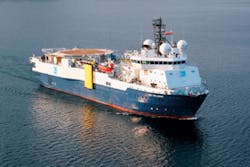Seismic technology advances accelerating to meet operators’ E&P needs.
Exciting new developments in seismic technology are emerging to meet the needs of operators as they explore for oil and natural gas in more challenging environments and increasingly complex geology.
In addition, there is a growing emphasis on improved clarity of subsurface feature images as operators step up the use of seismic applications for production, notably enhanced oil recovery (EOR).
3-D seismic
While it has proven itself to be the most important technology in the oil and gas industry of the past 2 decades, the next step-change beyond 3D seismic may be at hand.
Full-wave acquisition and processing is revolutionizing seismic imaging, just as 3D seismic did 20 years ago, contends Robert Peebler, president and CEO of Input-Output Inc., Houston.
“Present geophysical assumptions inherent in conventional 3D imaging limit our ability to image reservoirs and understand their contained fluids well enough to have maximum economic impact,” he says. “These are assumptions of isotropy, frequency band limits, vertical emergent angle, and the requirement for source-generated noise attenuation in the field.
“Because of these assumptions, 3D imaging as currently implemented has peaked in its usefulness and its ability to deliver additional benefit to the industry.”
Robert Brunck, president of Paris-based Cie. Générale de Géophysique (CGG), sees more sophisticated wave equation migrations as necessary for dealing with geologically complex settings, such as the Gulf of Mexico’s deepwater salt geometries and subsalt features: “These will accurately deal with all wave propagation phenomena in such complex settings. They are not only very computationally demanding but also require a much more accurate model of the subsurface to perform to their full potential.”
Brunck sees the next key developments in wave equation migration as steep-dip and turning waves, while very fast and targeted, or beam, imaging algorithms will yield interactive velocity model building and structural model validation.
“TTI (tilted anisotropy) will become the anisotropy standard and move to azimuthal anisotropy with the advance of wide-azimuth acquisitions and more OBS (node) surveys,” he adds.
One way of solving difficult offshore 3D imaging challenges such as subsalt and subbasalt are novel towing configurations, says Dalton Boutte, president, Schlumberger Ltd.’s London-based WesternGeco unit. These include over/under streamers and rich-azimuth shooting.
4D
What 3D has been to exploration, 4D seismic may prove to be for production.
Boutte contends that production will benefit greatly from further developments in 4D seismic, “as improved repeatability will enable more confident predictions of changes in fluid properties.
“Reductions in cycle time are making these measurements viable for active reservoir management. The advent of steerable streamers has provided our clients with the opportunity to treat every exploration project as a baseline 4D survey.”
While some see 4D essentially as just an extension of 3D, Brunck contends that view is changing.
“The trend for denser acquisition with a closer receiver spacing results in an increase in data volume,” he notes. “We also see a reduction in the period between successive vintages, as the detection of the 4D signal due to the oil production is highly related to the noise/repeatability level. Reducing the cycle time is a way to increase the signal quality, as is made possible by permanent installations.
“The challenge comes in the need to accommodate larger and more frequent data volumes and adapt from a static source of information (a simple snapshot/difference of two vintages) to the dynamic problem of tracking the movement/evolution of the 4D signature,” Brunck says. “The goal will be to replace the 4D difference with 4D predictability in a similar way to that used in weather forecasting.”
As operators in mature offshore areas such as the North Sea and Gulf of Mexico review their global asset portfolios of producing assets for candidates for continuous 4D seismic to optimize recovery, such permanent monitoring will become increasingly common, says Per Arild Reksnes, president, Geoscience & Engineering, PGS Marine Geophysical, a unit of Petroleum Geo-Services ASA, Oslo.
“Permanent monitoring using fiber optic technology is a very exciting growth area that we expect to see take off soon,” he says. “PGS has developed an entirely optical system that uses passive in-sea sensors and telemetry to record seismic data with high fidelity and dynamic range, in water depths as large as 3,000 m, and with low weight, great reliability, and improved costs per channel for deployment and operation.
“We are entering the commercialization phase and already are receiving a significant level of interest-often for applications that we had not previously considered.”
Multicomponent seismic
The potential for obtaining the range of information available in the full-wave field through multicomponent seismic has yet to be realized.
Multicomponent seismic remains a marginal business for the seismic industry, notes Brunck. The reason: Industry still does not have a clear understanding of how shear waves propagate, due to their tendency in certain layers to suffer from dispersion, attenuation, or splitting.
Nevertheless, the CGG chief says his company continues to press research in multicomponent seismic, notably in building new algorithms based on wave equation and in developing a special workstation, Vector Vista, dedicated to analyzing and interpreting multicomponent data.
Such innovative processing techniques are needed to leverage the digital full-wave information obtained with advanced multicomponent receivers, says Peebler. Vector filtering removes source-generated noise recorded by single-point receivers, resulting in a higher-bandwidth P-wave signal.
“There also has been great progress in processing converted wave data both onshore and offshore, revealing subtle subsurface features,” Peebler points out. “Longer-term research is focused on improving the utility and efficiency of processing and interpreting...multicomponent data, especially in complex acquisition environments such as the Arctic, desert, shallow-water, and ocean bottom, as well as when imaging fractured reservoirs.”
Also helping the multicomponent cause are advances in digital sensor technology, notably the MEMS (microelectromechanical systems)-based accelerometers that provide sensing capabilities not seen with conventional geophones. These sensors can record ground accelerations with very low distortion and very high accuracy in magnitude and orientation, says Brunck: “It therefore becomes possible to record the full-wave field with much improved vector fidelity.”
Borehole seismic
As acquisition hardware costs come down, industry is likely to make greater use of borehole seismic such as crosswell and vertical seismic profiling (VSP).
Brunck sees the development of larger tool arrays continuing, with CGG unit Sercel currently marketing a 32-level tool and expected to introduce a 100-level system in the near future.
“This push to longer arrays will stimulate the demand for 3D and 4D VSP, providing more resolution and certainty in VSP reservoir imaging,” he says. “This in turn will allow better linkage between VSP and surface seismic datasets.”
Furthering that effort will be advances in processing technology, notably in the area of imaging and migration, such as his firm’s new vector migration algorithm that can migrate multicomponent data as a single dataset.
Boutte contends that seismic data will realize their potential as quantitative oil field measurements when they tie with borehole data without being forced.
“With calibrated inversion of Q seismic data, rock and fluid properties can be propagated throughout the reservoir model in conjunction with geostatistics,” he says.
Massive channel counts
There is widespread consensus that industry is moving towards land seismic surveys with ever-larger numbers of channels, according to Brunck.
“If we look at the maximum channel count over the last 40 years, the trend is doubling every 3.5 years,” he says.
That trend, Brunck adds, is driven both by increased productivity and by such factors as single-sensor, three-component seismic, multi-azimuthal acquisition, and high receiver density, all in quest of a higher-quality image.
In the past 12 years alone, he notes, Sercel equipment has seen the weight per channel divided by 10 and power consumption by almost 3, while significantly increasing the data rate.
The channel-count records keep falling.
Boutte reports his firm’s Q-Technology capability to record more than 20,000 channels per shot with a marine configuration of eight 8-km streamers and as many as 25,000 channels with its land crews.
Visualization
The maturation of 3D visualization has progressed beyond novelty status to that of an effective, high-performance tool.
Volume rendering and immersive visualization have become widely accepted in efforts to navigate large datasets, notes Brunck.
“These capabilities will be taken one step further with the use of distributed rendering on cluster nodes that will allow 3D volumetric rendering of ultralarge datasets (several terabytes) on very large display walls with unequaled performance and resolution,” he predicts. “Combined with state-of-the-art compression and transfer technologies, this will allow these datasets to be efficiently visualized at remote locations even across low-bandwidth links.”
Boutte stresses that visualization techniques must be fast, quick to load, and easy to use if the full benefits of seismic as a reservoir tool are to be realized: “The main developments will be in usability, attribute display, and computing speed.”
Computing
The primary driver in the progress of seismic technology in the past 2 decades has been the huge leaps in computing power. And there is more to come, say industry experts.
“Our well-known ability to manage massive computer capacities will continue to be at stake with faster chips, greater storage capacity, and faster networks-to accommodate increasingly computer-intensive algorithms and larger data volumes, both for batch and interactive applications,” says Brunck.
One area where computing power growth will make a big difference is reverse time migration (RTM), which properly propagates wavefields through the most complex velocity regimes, including subsalt, for structures with >70° dips and in the presence of reflection boundaries that may generate internal multiples, says Peebler.
“Although RTM is not a new concept, its application has been limited due to lack of computational power needed to run the RTM algorithms cost-effectively and in a timely manner,” he says.
Peebler cites his firm’s efforts to improve RTM efficiency with its GX Technology, which it has begun to apply on several medium-sized commercial projects in the Gulf of Mexico.
Other advances
Thierry Pilenko, CEO and chairman of Veritas DGC Inc., Houston, cautions against overlooking the new ideas that might spring forth with new technology from data acquired with conventional seismic. One such example is applying wide-azimuth seismic to areas covered by vintage multiclient data, a trend Pilenko sees as accelerating in the near future, particularly in the North Sea and deepwater Gulf of Mexico.
“We think of multiclient data as a mine of information from which we can apply new ideas from the existing data and get a new product,” he says. “People don’t realize how much effort went into [developing the multiclient data libraries]. This is an area where seismic companies are not just delivering new products but building a knowledge base.”
Among other technology areas advancing the science of seismic, Boutte would like to see successful and efficient integration of seismic data with electromagnetic data, which “promises to be a significant contributor to both exploration and development applications for seismic data.”
Brunck contends the benefits of seismic technology to operators’ risk reduction and decision-making efforts have been proven in E&D and now need to be leveraged further into production.
“Beyond the initial breakthroughs in 4D, we have to concentrate on integrating more systematically seismic information into the workflow of production data and close linkage with reservoir properties,” he says. “This is within reach, given the very rapid evolution of the various technologies the seismic industry integrates for the E&P players.”
And some advances may come from outside the seismic industry altogether, notes Mike Bahorich, executive vice-president, exploration and production technology, Apache Corp., Houston.
“Apache recently made a significant contribution to the M.D. Anderson Cancer Center [in Houston] to aid imaging research,” he says. “Although this was predominantly a humanitarian gesture, advances in medical imaging may benefit our industry as well.”

